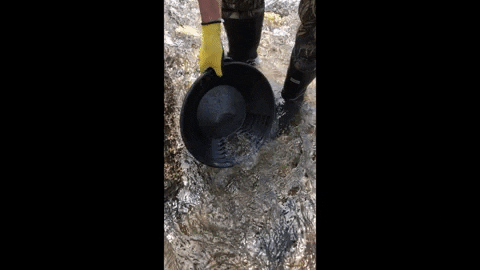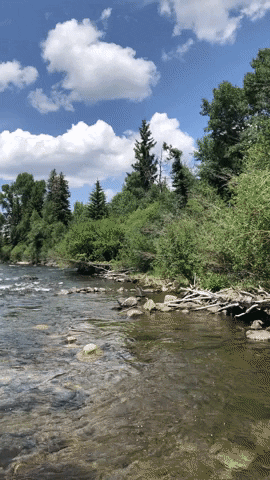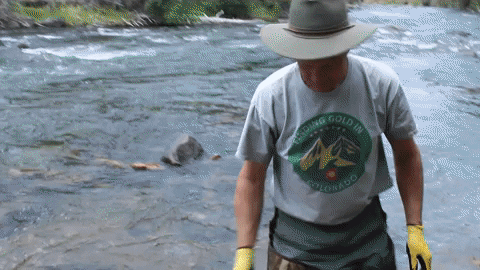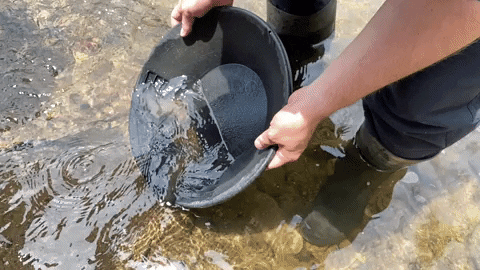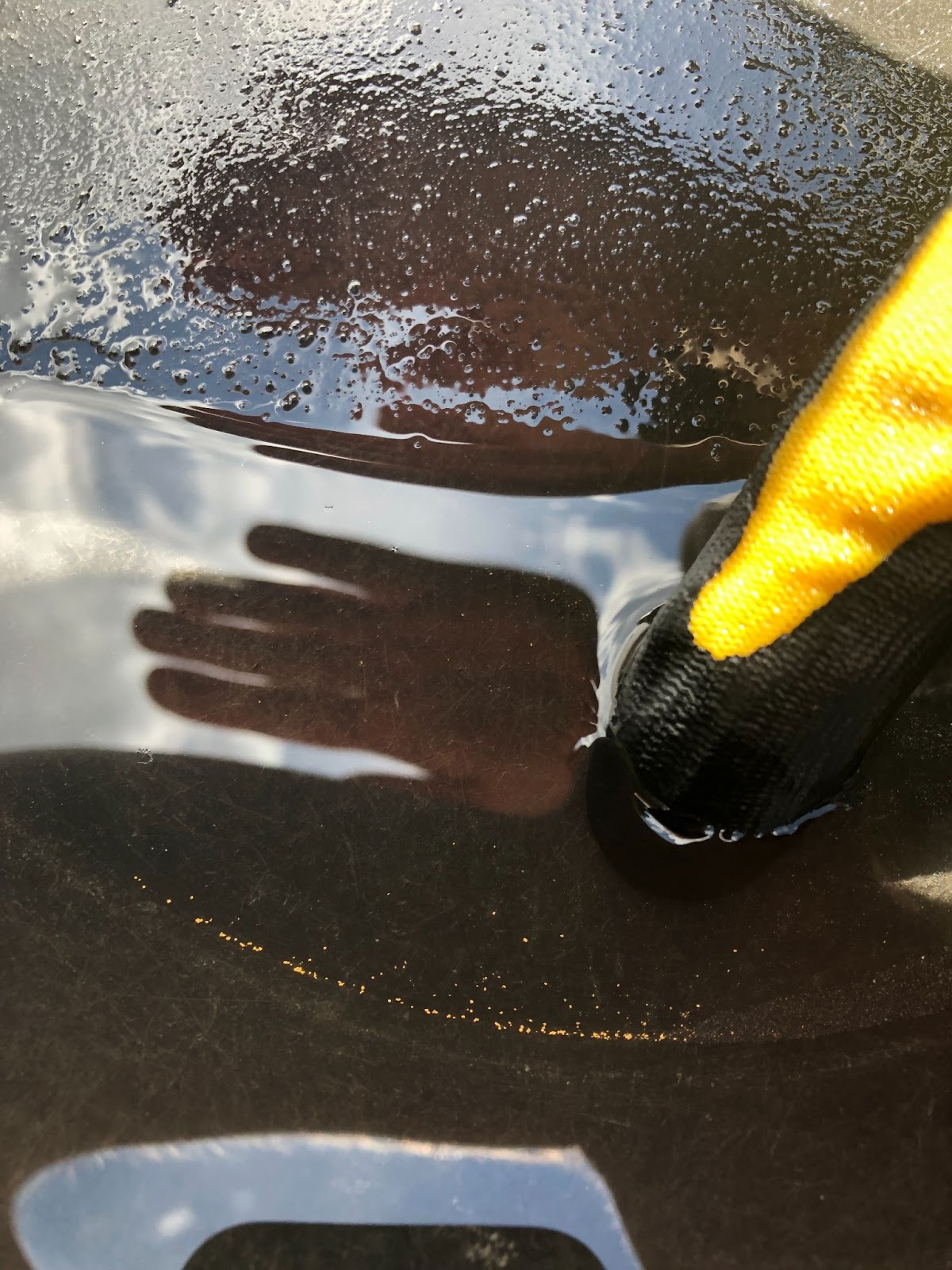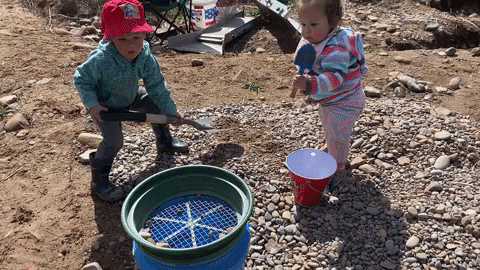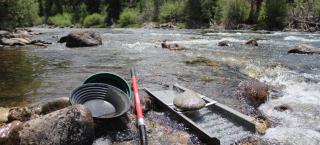
Story
The Prospect of Prospecting
Gold Panning in Colorado
The search for precious metals brought many immigrants to Colorado in the nineteenth century, but our mountain streams still draw adventurous gold seekers each year. Rachel Moyer interviews a longtime gold panner for The Colorado Magazine to explain how it all works.
Imagine a gold prospector. Do images of a thin man in overalls with a white, scraggly beard and a floppy hat come to mind? Maybe there is a covered wagon in the background and a make-shift campsite? Something akin to a still from an Old Western film?
What about a four-year-old or an ex-corporate consultant? For many people, the act of finding gold is something of the past. Seemingly, gold panning and gold prospectors are relics of the Colorado Gold Rush in the mid-nineteenth century.
In reality, gold has always been a part of Colorado’s story, even before Europeans arrived in the area. While the gold rush was definitely the most significant moment for prospecting in Colorado’s history, people have been finding precious metals in Colorado’s rivers and streams for centuries. Generally, anytime a new group explored the area, a survey of the land revealed varying amounts of metals and gems that were considered valuable.
While many people believe that all the gold in Colorado was scooped up during the gold rush, that simply isn’t true. Today, there are still communities of Coloradans that search for gold, mostly as a hobby. Some amateur gold panners enjoy the technique and science behind the activity, some just like something to do on a sunny day, and others are motivated by the jewelry and other items they can produce with their collection.
In an interview with The Colorado Magazine, amateur gold prospector and author of Finding Gold In Colorado Kevin Singel discusses how approachable gold panning can be. Here are some of Singel’s responses to questions from a prospecting newbie:
Rachel Moyer: First off, can you tell us what gold panning is?
Kevin Singel: Well, it's really the simplest way to find gold out in the wild.
What you're doing is gathering some sand and gravel from the bed of a river that flows through a gold-bearing area. And then, taking advantage of the fact that gold is much heavier than literally anything else in the river, separate it from the sand gravel.
If you get some water, sand, and gravel in your pan, and you shake it really hard, all the heavy stuff is going to fall to the bottom of the pan. Just like marbles in a bag of popcorn. If you think about a bag of popcorn with marbles in it, you give it a good shake and the marbles fall right to the bottom. You do the same kind of thing with sand and gravel; all the heavy stuff falls to the bottom. Then using a beach wave motion with your pan, wash the lighter material off the top. Shake it again and repeat until you get down to just the really, really heavy bits. There, you're likely to find some black sand, other metals in oxidized form, little pieces of lead from the fishers or hunters, and hopefully a few flakes of gold at the bottom.
Is this the only way that people find gold?
Well, it is the most common way. Even people that are looking for hard rock deposits would traditionally use panning to follow deposits of gold up a river. Then, they look for changes in the gold they're seeing in the pan. If there was suddenly less gold in the pan, for example, that might suggest that just downstream of them there was a hard rock deposit that had been eroding into the river and so they would backtrack a few hundred yards or so, hike up the hills, and look for the hard rock deposits.
So how did you get interested in gold panning?
For me, it started when I was six years old. My dad read me a National Geographic article about a gold rush that was occurring in Australia. I wasn't able to do much about that, living in Michigan at the time. Being six years old, one doesn't just go to Australia. But when we moved to Colorado in 1989, one of the very first weekends I went to a place where they teach you to gold pan. And by the time I left, I had a few flakes of gold. And I had bought a couple of gold pans. I was sucked in from the start.
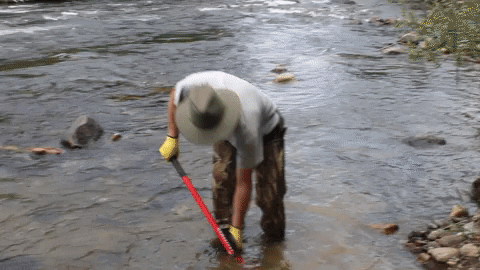
Kevin Singel shoveling rocks and sediment into a classifier on Blue River near Silverhtorne, Colorado.
So, what’s the process of gold panning?
The first thing you have to do is make sure you're allowed to dig where you want to. So, the first step is a matter of checking rules and regulations and ownership of the property.
[Once] you’ve confirmed you can dig in the place. If there's historically gold there, then there's still gold there, because the old timers didn't get it all by any stretch. So, what you're going to do then is dig up some of the sand and gravel from a likely looking spot on the river/creek bed. Using a shovel, you can get heaps of sediment and rocks from the creek bed and shovel them into your gold pan [or classifier], so you can start sorting out the bigger materials and refining the sediment down to just gold.
As far as picking a likely place goes, it helps to learn a little bit about how the sand and gravel in the riverbed moves during floods. Whether it's a big spring runoff year here in Colorado, or some kind of major rainstorm, when rivers get big, we've all probably seen how they'll get the color of chocolate milk during a big runoff event. When that happens, what you're seeing, of course, is lots of sediment in the river moving. But in a lot of cases, especially with the steep mountain river, in addition to that fine sediment there'll be bigger and heavier material moving as well. The fine sediment is where the gold is, usually in places where the river slows down.
Now, there are things you can do to make the job a little bit easier, like using [a] sort of a sieve called a classifier. Even a kitchen sieve or spaghetti strainer would do the job. What you're trying to do is remove the big rocks. Eventually, the goal is to only have a very small amount of material. So, if we get rid of the big stuff, it makes it easier to pan out the small stuff.
Place the classifier over the gold pan. After shoveling some rocks, gravel, and sediment on top of the classifier, give the pan and classifier a pretty aggressive shaking motion, because you want to get the heavy stuff to fall to the bottom. One of the things I see with beginners is that they're too tentative. You have to be pretty rough with it at first to get the stratification by density to occur. Gentler when there's less in the pan of course. So, it's a pretty aggressive shaking motion with a handful of sand, gravel, and water and then dipping it back into the river and moving the pan back and forth in a way that creates like a beach wave motion.
So, if you imagine a wave flowing in the beach and stripping off a little bit of sand from the surface of the beach as it washes back. That's what we're trying to try to simulate with the gold pan at that point. Doesn't matter if a little bit of water splashes out or not. New people tend to be too gentle because you're worried about losing something out of the pan, but of course, as soon as you start shaking the pan, the heavy gold starts to settle downward.
Once you get all the finest materials or the heaviest, densest materials at the bottom, you can start to actually see flakes of gold. Well, you have to work down to just a little bit of material. If you think about it, a gold pan probably starts out with something like a quart of material. And we're going to get down to a tablespoon or so before we have a chance of seeing the gold, because the gold is going to be absolutely at the bottom of the pan.
So how long does that usually take to get you from a quart of material all the way down?
For somebody who's brand new, twenty minutes. For me, two minutes, maybe three. It just comes with practice, and a willingness to be a little more aggressive with it.
Once you have the gold at the bottom of the pan, you have to be able to scoop it up so you can take it home. Usually, you’d use something like a suction pipette or an eye dropper just to pick up the tiny pieces of gold at the bottom. Then you bring it home and can pick out the really fine pieces there.
What tools do you need? You said a spaghetti strainer?
Yeah, a classifier, like your kitchen sieve or something like that, and a gold pan. If you had no money, I would say get yourself one of those aluminum pie plates and add a kitchen sieve. And you could at least start.
But what I'd suggest is that you get a prospecting kit. So, the prospecting kit would include a decent gold pan, a classifier, and they'll also give you a little eyedropper-type suction pipette to suck up the little bits of gold you find and a little vial to put them in, because you have to have a place to put your gold. They're available at prospecting shops, of course, or online. You know, places like Amazon do sell just about everything these days after all. So, you need: a shovel, some kind of classifier (sieve), a gold pan, a suction pipette, and a vial. Then you're pretty much good to go at that point. Ready to go find your first wild gold.
How does the gold that you collect become things that we want? Like jewelry?
Well, one of the cool things about gold as a mineral is that it comes out of the riverbed in its desired form. It's already pure gold.
Right now, it might have a little bit of other metals mixed in with it; silver and copper are common here in Colorado, for example, but it looks like the gold earring or the gold ring that you own already when it comes out of the creek. At that point, all that needs to be done to use it, whether it's for jewelry or the high-quality electrical contacts on your cell phone, is to melt it down and shape it into what you want it to be.
When you're making jewelry, for example, they'll mix it with other metals, because gold by itself is very soft. Most jewelry is 14 or 18 carats. What that refers to is the amount of gold in it versus other metals. So, 18 carats, for example, is 18 out of 24 parts, which is to say three-quarters; it's 75% gold. The other 25% would typically be silver and copper. The exact blends will vary depending on the color you're trying to get and how hard you want the metal to be and things like that. But that's the basic idea. I have made several rings, or had several rings made by goldsmiths with my gold. If you go to your neighborhood jewelry store and say: “do you have a goldsmith that comes in?” They'll say, “Oh yeah, she comes in every Wednesday afternoon to do repairs,” or something like that.
You come back, meet her, show her your little vial of gold you collected, and there's a chance she'll say “yeah, I can work with that.”
So, how much do you need to collect for a normal size ring?
To make a ring, probably five to seven grams is in the range of what you'll need. Remember, the goldsmith is going to mix it with some copper and silver. So, you actually end up with a little more volume in that sense than just the gold, you hand it to them, they won't use all the gold to make the ring.
What's the difference between yellow, white, and rose gold people find in the stores?
It's basically the alloys that are mixed with the actual gold.
So, rose gold might have more copper in it, for example, or other metals like that. A lot of the alloy combinations that they use are considered trade secrets. If you ask the jeweler what exactly is in their jewelry, they might be a little bit vague about it. Or they might tell you some of the other metals, but not what the exact percentages of the ratio is, because that's considered their art.
White gold is a bit of a special case, because of course, we all know what color gold is. Gold is gold colored. What they do is plate the gold with a thin layer of rhodium, which is insanely expensive, but also very, very hard. So, it wears well and stays shiny. Over time, it will wear off just like anything else, and eventually you're going to see a little bit of the gold color peeking out wherever it gets worn the most heavily, but rhodium is an extremely hard metal. Your white gold ring that's rhodium plated will tend to last a long time.
Do you need a license to pan? Or do you just need to know whose property you’re on?
Mostly you don't need a license. But of course, whether you need to buy some kind of license or permit depends on the property.
The state of Colorado doesn't require one, but certain lands do. Well, they don't actually sell gold panning licenses. Instead, you buy a fishing license, which is really just a license to be on and use their land. There is some conversation at the state legislative level about creating other kinds of licenses that would allow for other uses of the land where you're not actually going to be taking fish away. I mean, what if you want to just picnic? Well, you still need a license to use the land. So, a fishing license seems a little weird at that point, doesn't it?
There are some lands where you need a fishing license, specifically if they're managed by Colorado Parks and Wildlife. There are [also] a few places that are managed by either private parties that own the land or cities where they require you to buy some kind of a permit or join a club.
But there's an awful lot of places across the state, probably 150 or more, that don't require any licensing, paperwork, or paying anybody. You just show up and scoop up some sand and gravel out of the riverbed and see if you can find some gold.
What is a fun fact that you would like potential new prospectors to know?
There are lots of places around Colorado where you can learn to gold pan. One of the things I get a big kick out of is that in many of the historic gold rush places in Colorado, you can still go to that exact spot and stand there right where somebody stood and made their discovery and pan. So many of our mountain towns were founded during the gold rush. They allow people to go pan in the river or creek where the gold was first discovered and find their own little sample of gold. So, you can have that incredibly historic experience of doing the same thing somebody did in 1859 or 1860.
Do you think gold panning is a family activity?
Very much so, yeah. I would say developmentally, it's something that most kids can't do until they're about nine or ten years old. Just the act of gold panning requires some coordination and whatnot.
Now, that said, I've seen children be very successful gold panners at the age of four, with a little ten-inch gold pan and a modest amount of dirt at a time. Some kids can pick it up, especially if they've been watching the TV shows, because they know what they're doing… By the time you get to fifth or sixth grade, pretty much anybody can learn to gold pan in 10 minutes. It is a lot of fun to do as a family activity. And I have taken families out gold panning to teach them to do it, and they've had a great time. It's a lot of fun.
Does gold panning sound like an activity for you and your family?
According to Singel, the best way to begin gold panning is to just get out there and give it a try, with whatever materials you have, in a place where it’s legal to do so.
If you are more interested in the history of gold in Colorado, different gold panning techniques, or different locations to find gold, there are many resources available to you. Of course, Singel’s book Finding Gold In Colorado is a good place to start. You can find a link to Finding Gold In Colorado in the History Colorado bookshop. There is also a heap of online resources available. Facebook groups, YouTube channels, and websites are some digital resources. Here are some notable resources for novice gold panners:
Websites:
YouTube Channels:
Facebook Groups:
Many thanks to Kevin Singel, Laura Hoeppner, and William Singel for taking the time to talk about gold panning and actually getting out on the river for all the educational videos.

